
Nebraska Spent $3.7 Million On Doomed Airline
February 26, 2024
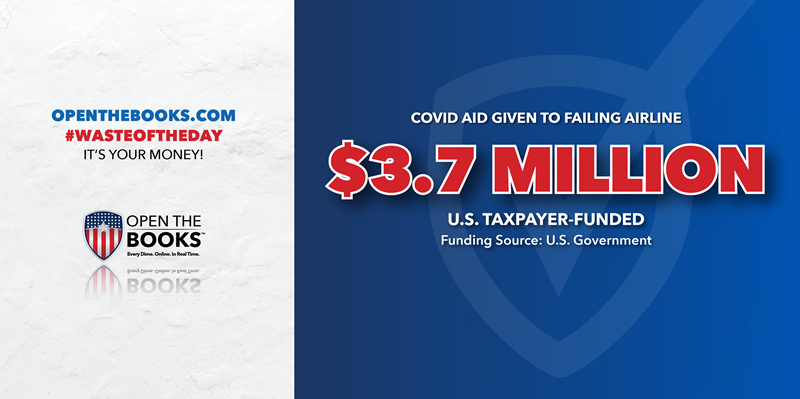
Topline: Red Way Airlines opened for business in June 2023 and went bankrupt less than three months later. In that time, it managed to suck up $3.7 million in pandemic relief money from the federal government and the state of Nebraska, a new state audit found.
Key facts: Red Way was conceived as a new way to offer affordable charter flights from the Lincoln, Nebraska airport. It received a $3 million grant to cover the losses most airlines suffer during their first few months, with Lancaster County and the City of Lincoln each contributing $1.5 million of their stimulus funds from the American Rescue Plan Act of 2021.
The airline’s inaugural flight traveled from Lincoln to Orlando on June 8. It was the only Red Way flight to ever turn a profit.
Issues with high operating costs and low demand for flights out of Lincoln quickly arose. Some flights took off half-empty. Tickets were available for $9.
Red Way’s grant request predicted that it would sell $8.8 million in tickets in three months, but actual sales were less than one quarter of that. Meanwhile, Red Way continued flights to seven destinations — higher than normal for a brand-new airline — meaning grant funds were quickly drained.
To try and save Red Way, county officials sent another $700,000 in funding before the airline folded.
All parties involved appeared to be blissfully ignorant to the airline’s impending doom. Ten days before the company shut its doors, Lincoln Airport sent an email to a Lancaster County official stating that business “continued to do well.”
The airline has still not refunded an estimated $100,000 in ticket sales for canceled flights, even after the Nebraska Attorney General got involved.
Critical quote: State Auditor Mike Foley said officials missed obvious warning signs about Red Way’s business strategy.
"Had the Red Way business plan been prepared for the eyes of a reputable commercial bank lender, its proponents would not have gotten past the junior teller," Foley said in a statement. "The cavalier treatment of government funds as monopoly money paved the way for the plan to be sold as a worthy risk to elected officials, who accepted it with few questions asked.”
Supporting quote: Lincoln Airport Authority’s Dave Haring said he did not regret taking a calculated risk on the airline.
"Certainly, we are all disappointed that it went through the proceeds as fast as it did. But I don't know that I would apologize for taking a chance to try to get air service in the community," Haring said.
Summary: Plenty of businesses have lied and committed fraud to secure pandemic relief funding. But Red Way’s only sin that led to wasting $3.7 million was genuine, earnest failure.
$38.5 Billion In Medicaid Funds Improperly Managed
February 27, 2024
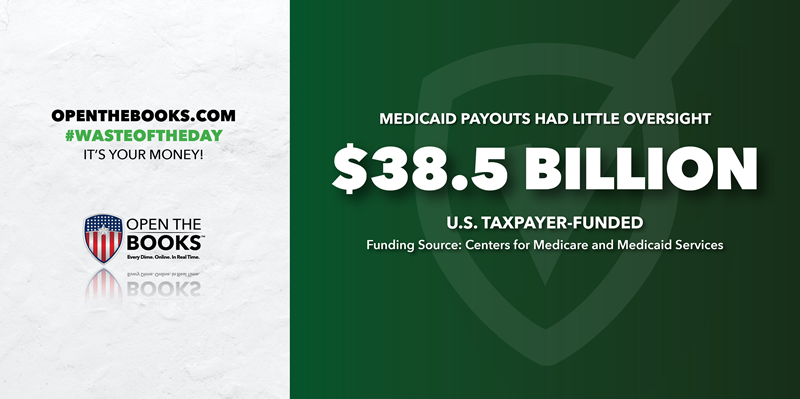
Topline: State governments spent $38.5 billion to increase Medicaid payouts in 2022, but there is little oversight of how the money is being used, according to a U.S. Government Accountability Office report.
Key facts: Typically, state governments send money to Medicaid Managed Care, which pays healthcare centers on behalf of patients as needed.
But since 2017, states have been allowed to send extra money directly to clinics to try and improve the quality of healthcare. The practice was originally meant to be used sparingly, but it’s becoming more common.
State governments spent over $38.5 billion on these “directed payments” in 2022, which are managed by the Centers for Medicare and Medicaid Services.
But according to the GAO, there are “weaknesses” in “CMS procedures for approving such payments.”
The report says that CMS has “weak fiscal guardrails,” meaning states often do not keep track of whether a healthcare provider is using its funds effectively before sending it more money.
The GAO evaluated five states and found that none of them were “consistently” evaluating whether the extra billions of dollars spent on Medicaid were actually having an impact on patient outcomes. In Texas, some hospitals received more than double the standard amount of funds, with little to no oversight.
The causes of this issue varied. Some states had flawed data software; some were simply not “implementing best practices.”
CMS also has not set any clear limits on the amount of money a single healthcare provider can receive.
Background: Eighteen states each spent over $500 million on directed payments in 2022, with California and Texas each giving out almost $7 billion.
Most of the money came from taxes on private healthcare providers, while some came from state general funds and other sources.
The United States spent $804 billion on Medicaid overall in 2022.
Summary: States are gaining more influence every year over how Medicaid funds are dispersed, yet they don’t have enough systems in place to prevent potential wasteful spending.
Virginia Taxpayers Likely to Spend $1.4 Billion on New Stadium
February 28, 2024
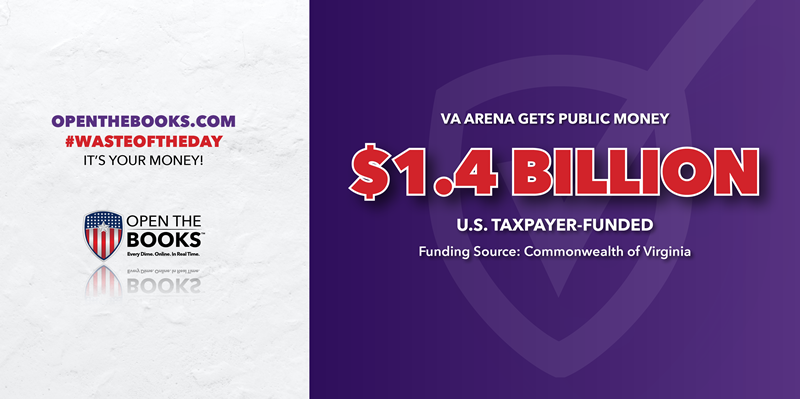
Topline: The Washington Wizards and Capitals have agreed to move to a new arena in Alexandria, Virginia, which would cost taxpayers an estimated $1.4 billion — even though the teams’ current arena in Washington D.C. just received $70 million in privately-funded upgrades.
Key facts: The proposed new stadium for the basketball and hockey teams would cost $2.2 billion, with $819 million coming from private sources. The City of Alexandria would spend $106 million and the Commonwealth of Virginia would cover the remaining $1.3 billion, according to a study obtained by the Washington Post.
Officials say most of the funding would come from bonds repaid with revenue generated by the arena itself, with taxpayers only liable for $300 million in direct costs. Still, if more private funding were secured, the extra revenue would be available to use for key government services instead of going back into the arena.
The agreement is nonbinding and still needs approval from state and local legislatures.
For that reason, Washington D.C. is still trying to keep the teams where they are. Mayor Muriel E. Bowser said the city would be willing to spend $500 million to renovate the teams’ current home of Capital One Arena, just short of the $600 million the teams originally asked for before looking for a new location.
That’s after the teams' owner spent $70 million of his own money on stadium upgrades just a couple of years ago
Capital One Arena was privately funded when it opened in 1997, but taxpayers spent $79 million for land purchases and construction around the site. That’s $150.3 million in 2024 dollars
Background: The Commonwealth of Virginia paid roughly $75 billion to outside vendors last year, with only five individual transactions — for core services like employee health insurance — totaling more than the $1.3 billion it will take to build a new arena, according to OpenTheBooks.com.
The City of Alexandria paid just $262.3 million to outside vendors and spent $206.4 million on its entire payroll in 2022. The city’s largest purchase that year was a $24 million contract with the Institute for Defense Analyses
It’s not chump change to the state or the city to spend $1.3 billion and $106 million, respectively, to subsidize a stadium.
Supporting quote: "We are not requiring a great deal of upfront investment, and we are not taking money away from the types of funds that fund public safety, the types of funds that fund education," Alexandria Mayor Justin Wilson told Fox News. "In fact, it’s quite the opposite, we are generating money that we’re going to be able to use to invest in those kinds of very important roles of government."
Critical quote: “Anyone who thinks I am going to approve an arena in Northern Virginia using state tax dollars before we deliver on toll relief and for public schools in Hampton Roads must think I have dumb*** written on my forehead,” State Senator L. Louise Lucas said on social media.
Summary: Taxpayer-funded stadiums have been a common issue across the country during the last few years. What isn’t common is for two cities to compete to see who can burn more money on a single building.
Throwback Thursday: Senate Restaurants Use Taxpayer Funds to Pay Expenses
February 29, 2024
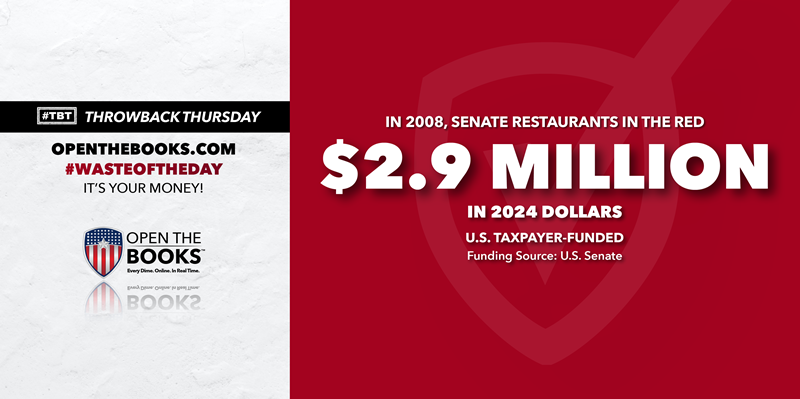
Throwback Thursday!
Topline: Taxpayers spent $2 million to feed their senators lunch in 2008, as Capitol restaurants posted their worst-ever net loss that year and dipped into emergency funds.
Senators had to pay for their own meals, but after accounting for payroll and other expenses, their cafeterias lost $2.9 million in 2024 dollars.
That’s according to the “Wastebook” reporting published by the late U.S. Senator Dr. Tom Coburn. For years, these reports shined a white-hot spotlight on federal frauds and taxpayer abuses.
Coburn, the late U.S. Senator from Oklahoma, earned the nickname "Dr. No" by stopping thousands of pork-barrel projects using the Senate rules. Projects that he couldn't stop, Coburn included in his oversight reports.
Coburn's Wastebook 2008 featured 65 examples of outrageous spending worth more than $1.3 billion, including the $2 million restaurant operating deficit.
Key facts: Senators used to dine in cafeterias managed by the government agency Senate Restaurants.
From 1993 to 2008, the restaurants lost over $18 million, forcing taxpayers to provide subsidies. The cafeterias operated at a deficit in 37 of 44 years and averaged an annual loss of $900,000.
The issue wasn’t that senators were paying too little for their meals; a sandwich and chips cost $11.50 in 2008, which is $16.38 today.
But poor business practices meant the Senate needed to take $250,000 from its emergency funds to keep the restaurants open and send paychecks to waitstaff on time.
The Senate voted to privatize its restaurants in June 2008.
But, not to worry: before making the switch, Senators passed a bill to ensure taxpayers would still be on the hook for the old restaurants’ employee pensions, insurance and accrued sick days.
Today, two private companies run seven restaurants for the Senate. One source of consistency: a little-known and poorly understood 1903 mandate requiring bean soup to be on the menu every day continues to be upheld.
Critical quote: “Candidly, I don’t think the taxpayers should be subsidizing something that doesn’t need to be,” Sen. Dianne Feinstein wrote in a 2008 letter. “Financially breaking even has not been the objective of the current management due to an expectation that the restaurants will operate at a deficit annually.”
Summary: Most restaurants would not be able to survive a year of $2 million in losses, let alone several years in the red. Apparently, that same principle does not apply when taxpayer money is at stake.
U.S. Sent $1.2 Billion to Hamas-Backed UN agency
March 1, 2024
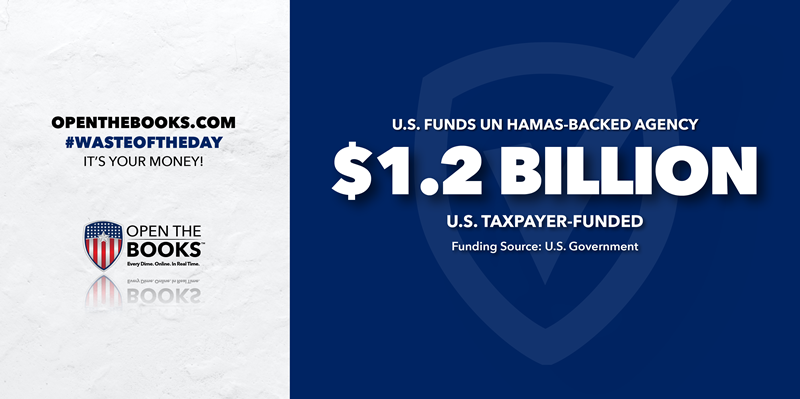
Topline: The U.S. government has given $1.2 billion to the United Nations Relief and Works Agency since April 2021, according to a report from OpenTheBooks.com.
UNRWA exists to provide humanitarian support for Palestinian refugees. But 10% of the agency’s employees are believed to have connections to the terrorist group Hamas, according to a recent Wall Street Journal report.
At least 12 employees were directly involved in the Oct. 7 attacks against Israel, including one teacher who allegedly kept a hostage in his attic for 50 days.
Key facts: U.S. taxpayers have spent over $8 billion to help Palestinian refugees since 1950, OpenTheBooks found.
The U.S. has provided almost one-third of UNRWA’s total funding, more than any other country. President Barack Obama’s administration spent more than any other president, with annual payments reaching nearly $400 million.
Former President Donald Trump cut all aid to UNRWA for the first time in 71 years because of concerns it could support Hamas and the Palestinian Liberation Organization, which used funds to support the families of dead terrorists.
President Joe Biden restarted U.S. support in 2021 and spent over $300 million each year. Biden said at the time that providing balanced support to both Israel and Palestine was the best way to work toward a two-state solution.
But concerns were expressed as early as 2014 that UNRWA was “effectively a branch of Hamas.”
Even after Oct. 7, the Biden administration sent another $121 million in Palestinian aid to UNRWA. Funding did not stop until this January.
A Biden-backed bill moving through Congress would redirect UNRWA funding toward other humanitarian groups in Gaza.
Critical quote: Ethan Mayer-Rich of the Arab Center Washington D.C. opposed the U.S.’s recent decision to pause UNRWA funding.
“We’re seeing a pretty quick departure from what used to be a split down party lines,” he said. “It’s reckless, and ultimately I think history is going to see [the U.S.] as being completely complicit in what is unquestionably an incredibly tragic and dire situation.”
Supporting quote: Rep. Darrell Issa (R-CA) wants the U.S. to permanently end UNRWA funding, not just temporarily pause it.
“Weapons have been found in UNRWA schools. Hamas tunnels have been found adjacent to UNRWA facilities. Hamas has stolen $1 million in UNRWA supplies since October 7, while UNRWA facilities may have been used to hold hostages,” Issa said in a letter obtained by the New York Post. “UNRWA has also faced longstanding criticism over its educational programing which indoctrinates Palestinian youth in antisemitism and terror.”
Summary: Concerns have long existed that the $1.2 billion the U.S. sent to UNRWA since 2021 could be used to fund terrorist activities. Tragically, those concerns appear to have been borne out.
The #WasteOfTheDay is presented by the forensic auditors at OpenTheBooks.com.